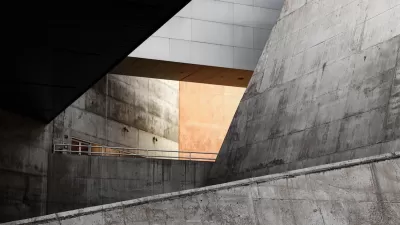While it doesn't sounds like the most historically sensitive renovation, designLAB's reworking of Paul Rudolph's Carney Library at UMass Dartmouth shows that Brutalist monoliths can be adapted to suit contemporary needs and tastes.
Robert Campbell reviews designLAB's nearly complete renovation and redesign of Randolph's Brutalist Claire T. Carney Library: "a lesson in mixing the old and the new and getting a result that’s better than either." While others debate the merits of saving relics from this hard to love period of architectural history, Campbell argues that designLAB's work makes a strong case that such buildings can be revived with an intelligent approach that builds off its strengths and softens its weaknesses.
"DesignLAB’s architects get their role exactly right. They admire Rudolph, they’ve researched his intentions and worked to restore them, but at the same time they’re fearless about knocking down his stuff and adding their own. They do that wherever it’s needed to make a better experience for the library’s users."
"In a world of diminishing resources," says Campbell, "it makes less and less sense to demolish and replace even a difficult and controversial piece of architecture like Rudolph’s old Carney. But the fact that a building was designed by a famed architect doesn’t mean you have to treat it as a sacred object, either. The Carney offers an important lesson: that often the best way to get a good new building is to grab a great old one, give it a good hard shake, and reinvent it for another era."
FULL STORY: Paul Rudolph’s Brutalism, reworked, at UMass Dartmouth

Maui's Vacation Rental Debate Turns Ugly
Verbal attacks, misinformation campaigns and fistfights plague a high-stakes debate to convert thousands of vacation rentals into long-term housing.

Planetizen Federal Action Tracker
A weekly monitor of how Trump’s orders and actions are impacting planners and planning in America.

San Francisco Suspends Traffic Calming Amidst Record Deaths
Citing “a challenging fiscal landscape,” the city will cease the program on the heels of 42 traffic deaths, including 24 pedestrians.

Defunct Pittsburgh Power Plant to Become Residential Tower
A decommissioned steam heat plant will be redeveloped into almost 100 affordable housing units.

Trump Prompts Restructuring of Transportation Research Board in “Unprecedented Overreach”
The TRB has eliminated more than half of its committees including those focused on climate, equity, and cities.

Amtrak Rolls Out New Orleans to Alabama “Mardi Gras” Train
The new service will operate morning and evening departures between Mobile and New Orleans.
Urban Design for Planners 1: Software Tools
This six-course series explores essential urban design concepts using open source software and equips planners with the tools they need to participate fully in the urban design process.
Planning for Universal Design
Learn the tools for implementing Universal Design in planning regulations.
Heyer Gruel & Associates PA
JM Goldson LLC
Custer County Colorado
City of Camden Redevelopment Agency
City of Astoria
Transportation Research & Education Center (TREC) at Portland State University
Jefferson Parish Government
Camden Redevelopment Agency
City of Claremont



























